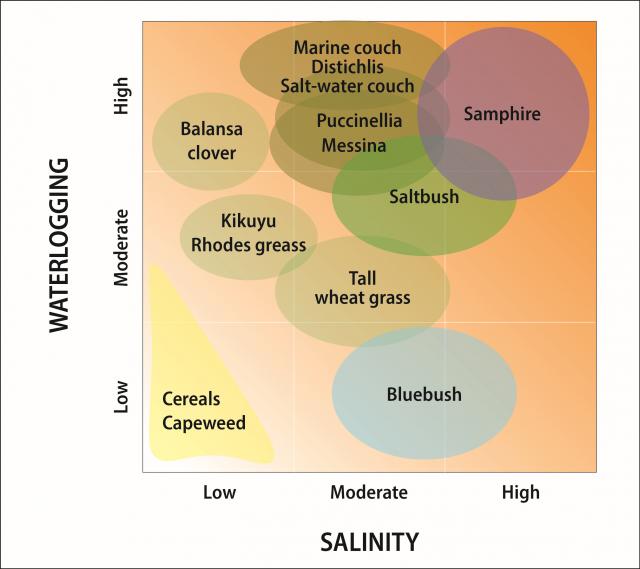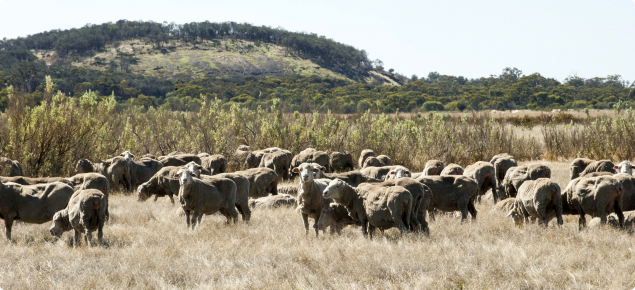Productivity and economics of saltland pasture
Saltland pastures, rather than revegetation or engineering, assumes that the area will be grazed by livestock and remain as a saltland site. Saltland pastures can be a profitable adaptation to the condition.
Productivity and profitability of the system depends on:
- having the right infrastructure: earthworks, fencing, water supplies
- having the best pasture species for the site
- managing grazing to get the best whole-farm financial returns, and to maintain pasture productivity.
Steps to establish a productive saltland pasture
- Know your site.
- Carry out any drainage and upslope earthworks first.
- Fence the area and provide watering points.
- Choose the right plants.
- Choose the establishment method.
- Prepare the site for planting.
- Plant or seed using good practice.
- Manage grazing and livestock health.
- Maintain saltland pasture productivity.
Know your site
You need to know the existing salinity extent and severity, and the risk of increasing salinity.
See:
Drainage and water management
Prevent inundation and reduce waterlogging to improve the productivity of salt tolerant pastures. The intent of this management is not to reduce the area of salt affected land.
See Surface water management for more information.
Choosing the right plants
Choose the plants that:
- match the salinity and waterlogging conditions found on the site, or expected to be present after site preparation – Figure 1 shows the relative tolerance of plants to waterlogging and saliity level
- have good energy and protein content
- produce plenty of digestible dry matter per hectare
- do not result in toxic levels of salt or nitrates being eaten by livestock.

For more information, see:
- Pasture legumes and grasses for saline land
- Saltbushes for dryland salinity management
- plant species in Plant-based options for managing dryland salinity.
Each plant based option web page has information on grazing and agronomic management.
Managing saltland pastures
Establishing saltland pastures
To successfully establish saltland pastures, choose the right species, use good seed or seedlings, control waterlogging, and use the right establishment methods. The steps below assume that the site has been checked – see assessing saline areas.
We recommend these steps:
- Establish the infrastructure: surface water earthworks upslope and onsite, fencing, livestock watering points.
- Choose the planting technique: direct seeding or seedlings.
- Prepare the site for the technique chosen: weed and pest control, soil seedbed or seedling preparation.
- Plant the chosen species in the recommended order for the design chosen.
See Establishing saltbush and understorey for dryland salinity management for detailed recommendations.
Saltbush shrubs
Saltbush species are used as the backbone of a productive saltland grazing system with understorey species sown to complement the system and increase pasture production. Research has revealed that establishing saltbush with seeds is best when soils have a minimum of 10–15 cm sand over clay. If less than 15 cm, then seedlings either planted by hand or machine will give better establishment.
The type of saltbush system and species you choose depends on the severity of saltland and helps decide your target plant density. Typical plant densities are listed in the Table 1 and 2. How you achieve those densities can depend on needs and machinery available.
Block system
Figure 2 shows a block planting of old man and river saltbush at Ongerup. Rows are 2.5 m wide and plants are 2.5 m apart giving a density of 1600 plants per hectare.
Block system plantings are best used on moderate to severely-affected saltland and can range from 1000 to 1600 plants per hectare. Table 1 below shows planting distances and densities to use according to salinity class.
| Saltland class | Distance between plants (m) | Distance between rows (m) | Plant density (plants/ha) |
|---|---|---|---|
| Moderate | 2 | 5 | 1000 |
| Moderate | 2.5 | 4 | 1000 |
| High | 3 | 3 | 1100 |
| High | 2.5 | 2.5 | 1600 |
When planning, include the occasional 10m wide track for vehicle access.
Alley system
Alley system plantings are best suited to mild to moderate saltland. A common configuration is two to four rows of saltbush with the width of the alleys dependent on severity of salt. Generally the more saline, the more saltbush plants are required and consequently alley widths reduce. Planting density can range from 600 to 960 plants per hectare.
Figure 3 shows an alley saltbush system at Tambellup. Tall wheat grass was sown first with a airseeder and can be seen growing in the alley. The saltbush was planted in sets of four rows, with rows 2.5 m wide and plants 2.5 m apart. The alley is 10 m wide, giving a planting density of 910 plants per hectare.
Table 4 Alley planting recommendations according to salinity class
| Saltland class | Alley width (m) | Distance between plants (m) | Distance between rows (m) | Plant density (plants/ha) |
|---|---|---|---|---|
| Slight | 20 | 2 | 5 | 600 |
| Moderate | 12 | 2.5 | 4 | 800 |
| High | 10 | 3 | 3 | 960 |
Figure 4 shows groundwater changes from 1994 to 2002 for no saltbush (thin line) and with saltbush (thick line) at Lake Grace. Water levels were reduced by 0.9m. This level of reduction allows annual pasture species with no salt tolerance to establish and survive, and provide water to retain the saltbush component.


